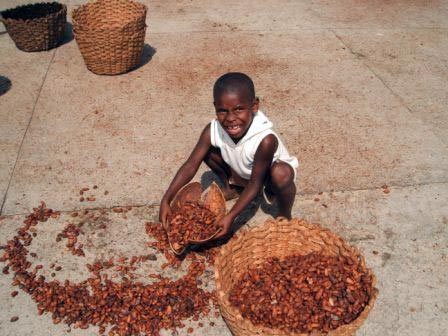
A short time ago, I posted on poverty and the growing world population (7 billion and counting), and about the challenge of deciding how to respond (The cost of addressing world poverty).
Let’s start with something small which most of us can do this week, or this year.
The bitter truth about chocolate
Chocolate is big business. The figures on the internet don’t always agree, but here is as good a summary as I can find:
- The chocolate confectionary business is worth about $70 billion worldwide.
- About 80% of the world’s cocoa is grown in West Africa, with Cote d’Ivoire accounting for about half of this.
- The world’s cocoa crop is worth about $5 billion per year, and 40-50 million people depend on cocoa for their livelihood.
- Child labour is common in West Africa and according to this BBC report, 1.8 million children work in the production of cocoa. Some assist on poor family farms, but it is estimated that about 10,000-15,000 are illegally trafficked and forced to work as slaves on cocoa plantations, working under extremely harsh conditions (see Wikipedia, University of America, and Soul Economy.
There can be no doubt that some of the chocolate we all eat was grown on plantations which exploit and abuse slave children.
World response
This situation has been publicised in recent years and slow steps are being made towards alleviating the situation:
- The cocoa and chocolate industries and the governments of Ghana and Cote d’Ivoire have set up certification procedures and protocols to reduce slave labour, but progress so far has been slow.
- Several different certification processes (Fair Trade, Rainforest Alliance, UTZ have been set up and a number of small manufacturers offer chocolates certified as child labour free. However these brands account for less than 1% of all chocolates bought, and sometimes things can still go wrong.
- Larger manufacturers have responded slowly. In Australia, major manufacturers Cadbury, Nestle and Mars each have one certified product among their extensive ranges.
Making a difference
We, the chocolate buying public in the rich western world, can make a difference.
- We can make a shift in our purchases. This will involve some sacrifice, as certified chocolates are often more expensive and have a much smaller range. It is not realistic to only purchase certified chocolate, but we can go a long way towards that.
- We can write to chocolate manufacturers encouraging them to use certified child labour free cocoa. If we are willing to change our buying habits, we can explain this to the manufacturers.
It seems like a small price to pay
I have begun, falteringly, to move in this direction. I am beginning to amend my chocolate buying habits and will try to find more Fair Trade alternatives. And I have written to the manufacturers of the two brands of chocolates I eat most. I wrote to Cadbury, complimenting them on making one of their range Fair Trade, but suggesting chocolate eaters with a conscience might like greater choice. And I wrote to local confectioner, Darrell Lea, who have no Fair Trade products, asking them to consider taking this step.
I’ll report back what they say.
UnkleE, this is a little off-topic, but have you heard of the Nestlé boycott campaign?
Was it about infant formula vs breast milk in poor countries?
Exactly, several NGOs claim Nestlé uses unethical marketing techniques for its dry formula in countries with poor access to safe drinking water. What are your thoughts were on the issue?
I’ve not investigated it to know the facts, but I’m inclined to feel Nestle was not behaving well.
[…] of weeks ago, I outlined some facts about exploitation in the growing of cocoa for chocolate (see My pleasure, their misery?) and at the same time wrote to two prominent chocolate manufacturers expressing my concerns and […]
[…] in November I reported on exploitation in the world cocoa trade in My pleasure, their misery?. At that time I wrote about this to two prominent chocolate […]
[…] chocolate, due to the trafficking and exploitation of children in growing cocoa in West Africa (see My pleasure, their misery? and Easter eggs and slavery), and on the responses to my letters to chocolate manufacturers (see […]